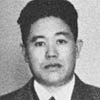
Guntaro Kubota
Guntaro Kubota was born in Nagano, Japan on August 16, 1903. He studied Japanese law and graduated from Meiji University in Tokyo. He emigrated to the U.S. in 1924 on the last boat before the U.S. closed the door to Japanese immigration. In the U.S. he worked as a cook's helper for lumberjacks on Mount Rainier in Washington before getting a job as a Japanese language schoolteacher in Cupertino, California. In 1937 he married one of his students, a Nisei woman named Gloria Tsugiko Kasano. Together they had a daughter, Grace Makiko, born six months before Pearl Harbor.
At Heart Mountain Kubota was the only Issei immigrant among the leadership of the Fair Play Committee. He translated the FPC bulletins into Japanese to help raise money for the court case from the Issei in camp. He was warned his involvement could lead to charges of espionage or sabotage and even a possible death penalty as he was by law an "enemy alien" not eligible for citizenship. As such he was also not eligible for the draft, yet he openly stayed a part of the resistance, saying he was fighting for the rights of his Nisei children. His son, Gordon Hidemaro, was born inside camp 10 days before Kubota's arrest for conspiracy to counsel draft evasion.
After his release from the federal penitentiary at Leavenworth, Kansas, the family resettled in Saratoga, California, where Kubota obtained a license as a landscape contractor. He was once featured in a Sunset Magazine book on Japanese gardening.
|



